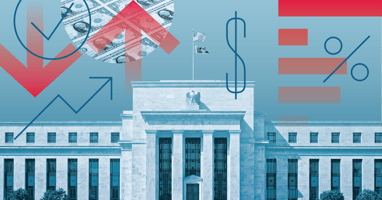The old adage “Sell in May and go away” didn’t hold up this year. After a sharp sell-off and rally...
Markets Climb Despite the Crosswinds: Trade, Tariffs, and the Fed
A Rally Through the Noise
Markets extended their resilience in June, shaking off geopolitical tensions and trade policy uncertainty to close out the second quarter with strong gains. The S&P 500 rose 5.0% for the month, finishing Q2 up 10.6%, while the Nasdaq Composite climbed 6.5% in June and 17.8% for the quarter. Investors appeared largely unbothered by Middle East conflict and tariff threats, instead rotating back into equities amid cooling inflation data and growing expectations for interest rate cuts. Despite lingering risks, sidelined cash returned to the market with force.
Sector leadership remained concentrated, echoing trends since the April 8 tariff-induced market low. Technology led the way with a 9.9% gain, followed by Communication Services (+7.3%) and Energy (+4.9%). Defensive areas lagged, with Consumer Staples falling 1.6%, though still up 4.3% year-to-date.
Markets Discount War and Tariffs—for Now
The major escalation between Iran and Israel—including a U.S. airstrike and a symbolic Iranian missile response—briefly spiked oil prices to $75, but markets quickly stabilized after a brokered ceasefire by President Trump. Oil retreated below $65, and investor anxiety eased.
Trade developments remain a wildcard. With a July 9 deadline looming, the Tr ump administration is poised to reinstate sweeping tariffs. Steel duties have already doubled to 50%, and a 55% tariff package on Chinese imports is under discussion. Nonetheless, markets appear to be pricing in either partial extensions or limited near-term economic impact.
ump administration is poised to reinstate sweeping tariffs. Steel duties have already doubled to 50%, and a 55% tariff package on Chinese imports is under discussion. Nonetheless, markets appear to be pricing in either partial extensions or limited near-term economic impact.
Fiscal Policy Uncertainty in Focus
Investor sentiment was buoyed by anticipation of the "One Big Beautiful Bill"—a comprehensive tax and spending package—passing Congress. The Senate approved the bill on July 1, sending it back to the House amid internal Republican debate. The Congressional Budget Office estimates the bill would add $2.4 trillion to the deficit over 10 years—but other estimates put it at $4 trillion—raising concerns over fiscal sustainability, future interest rate pressure, and dollar stability.
Economic Data Shows Mixed Signals
Economic indicators painted a murky picture. Both ISM Manufacturing and Services indices fell below 50, signaling contraction. May personal income and consumption weakened, surprising economists. Inflation has been trending lower but remains sticky nonetheless, with core PCE Price Index rising 0.2% month-over-month and the annual rate ticking higher at 2.7%. Purchasing managers surveys point to renewed price pressures. Q1 GDP was revised down to -0.5%, while retail sales, construction, and industrial production underperformed. At the same time, core durable goods orders rebounded, surprising to the upside after April’s sharp decline. Similarly, Q2 GDP is expected to recover as the economy adjusts to the Q1 import surge that preceded anticipated tariffs.
Labor market data was more stable. The U.S. added 139,000 jobs in May, wage growth ticked up to 0.4% month-over-month and 3.9% year-over-year, unemployment held at 4.2%, and jobless claims remain in a healthy range. However, the big shifts in immigration may be distorting the data and making it difficult to determine the true state of the labor market. Small businesses reported net job losses, suggesting a cooling jobs market beneath the surface.
Fed on Hold, Cuts in Sight
The Federal Reserve kept rates steady at 4.25%–4.50% in June, acknowledging softer growth while maintaining caution amid sticky inflation. Chair Powell emphasized the Fed’s willingness to stay on hold until it sees clear data on the inflationary effects of tariffs or further economic weakness.
We continue to expect two rate cuts in the second half of the year. However, signals from the bond market and Fed funds futures remain conflicted. Meanwhile, momentum on tax legislation could bolster corporate earnings and benefit high-income households to support growth. Still, any resulting expansion of the federal deficit may place upward pressure on long-term rates and contribute to more weakness in the U.S. dollar. This combined with renewed tariff escalation could limit the Fed’s flexibility
Looking Ahead
While the economic backdrop continues to deteriorate gradually, markets remain supported by abundant liquidity, easing near-term concerns over trade and geopolitical conflict, and persistent enthusiasm for growth-driven themes. We believe we are nearing the point where the economic and inflationary impact of tariffs will begin to show. The second half of 2025 is likely to be shaped by the interplay between fiscal stimulus, tariff implementation, and the Federal Reserve’s policy decisions. We remain defensively positioned in U.S. equities, balancing that exposure with higher-yielding bonds. At the same time, international markets have continued to present attractive opportunities, providing a meaningful tailwind to client portfolios


